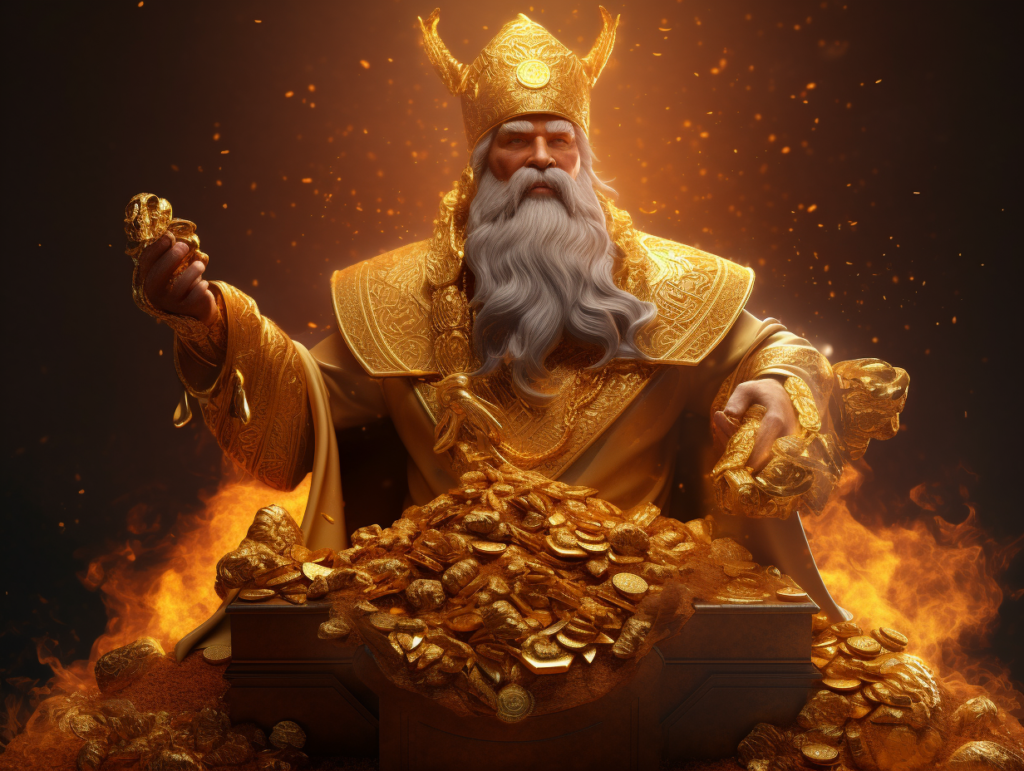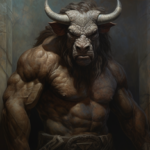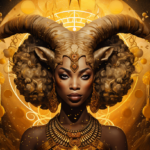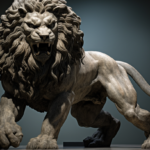Are you ready to unlock the secrets of wealth and prosperity? Look no further than Fáfnir, the Norse god who possesses the power to bless mortals with untold riches.
In this article, you will delve into the origins and role of Fáfnir in Norse mythology, discovering the symbols of wealth and the dangers of greed.
Prepare to be captivated by Fáfnir’s transformation into a greedy dragon and explore his mythical treasures.
Brace yourself for a journey that will leave you empowered with the knowledge of wealth and prosperity in modern Norse culture.
Key Takeaways
- Fáfnir’s story serves as a cautionary tale of the destructive nature of greed and unchecked ambition.
- The symbols associated with Fáfnir, such as Mjölnir, Draupnir, Brísingamen, and Yggdrasil, tap into the power and wisdom of Norse gods for prosperity and success.
- Fáfnir’s transformation into a dragon symbolizes the corruption of material wealth and the potential consequences of excessive desire.
- The hoard of treasures associated with Fáfnir, including the Ring of Andvaranaut, the Cauldron of Plenty, the Sword of Greed, and the Horn of Abundance, represent the rewards and dangers of extreme wealth accumulation.
Fáfnir: The Norse God of Wealth and Prosperity
Fáfnir is known for his role in bringing wealth and prosperity to those who worship him. As you seek power and desire to amass great wealth, you must understand the significance of Fáfnir in Norse mythology. This mighty god, revered by many, holds the key to unlocking the secrets of abundance and success.
Legend has it that Fáfnir was once a powerful dwarf who possessed an insatiable thirst for power and wealth. Consumed by greed, he transformed into a monstrous dragon, guarding his vast treasure hoard with a fierce determination. Many have tried to claim his riches, but only those who’ve shown unwavering devotion and respect have been blessed with his favor.
To gain the favor of Fáfnir, one must demonstrate an unwavering commitment to their goals and an unyielding hunger for success. This requires a relentless drive, a strategic mindset, and the willingness to take calculated risks. Fáfnir rewards those who understand the value of hard work and perseverance, and he bestows upon them the riches they seek.
Origins and Role of Fáfnir in Norse Mythology
As you delve into the origins and role of Fáfnir in Norse mythology, it becomes evident that his story is one of both fascination and cautionary tales. Fáfnir, a powerful and enigmatic figure, was once a greedy dwarf who transformed into a fearsome dragon due to his insatiable desire for wealth and power. His insidious lust for gold consumed him, turning him into a merciless creature that hoarded treasures deep within his lair.
Fáfnir’s role in Norse mythology serves as a stark reminder of the dangers of unchecked ambition and the corrupting influence of greed. His transformation into a dragon symbolizes the transformation of a once honorable being into a monstrous creature driven solely by material wealth. Fáfnir’s insatiable desire for riches ultimately led to his demise, as he was slain by the hero Sigurd in an act of righteous vengeance.
However, despite his tragic fate, Fáfnir’s story also holds a certain allure for those who desire power. His vast hoard of treasures represents the potential rewards that await those who are willing to go to extreme lengths to amass wealth. Fáfnir serves as a cautionary tale for those who seek power at any cost, reminding them that the pursuit of material gain can lead to their downfall.
Symbols and Representations of Wealth in Norse Mythology
As you explore Norse mythology, you will discover that there are various symbols and representations that depict wealth and prosperity. These symbols hold great significance and convey a deeper meaning for those who seek power and abundance. Allow me to enlighten you about some of these symbols:
| Symbol | Representation |
|---|---|
| Mjölnir | The mighty hammer of Thor, symbolizing strength and protection. It represents the power to conquer obstacles and amass great wealth. |
| Draupnir | A magical ring owned by Odin, which has the ability to multiply itself. It signifies abundance and the never-ending flow of riches. |
| Brísingamen | A beautiful necklace worn by Freyja, the goddess of love and beauty. This symbol of feminine power represents not only wealth but also seduction and allure. |
| Yggdrasil | The great World Tree that connects the nine realms. It symbolizes the interconnectedness of all things and the infinite possibilities for wealth and prosperity.
These symbols serve as reminders of the potential for wealth and abundance that lies within Norse mythology. By embodying the qualities they represent, you can tap into the ancient power and wisdom of the Norse gods and goddesses, paving your path towards prosperity and success. Embrace these symbols, harness their energy, and watch as wealth flows into your life.
Fáfnir’s Transformation Into a Greedy Dragon
Now let’s talk about Fáfnir’s transformation into a greedy dragon and the consequences of his greed.
When Fáfnir became consumed by his desire for wealth, he underwent a dramatic transformation, turning into a fearsome dragon.
This transformation serves as a powerful symbol of the destructive nature of greed and the lengths one may go to fulfill their insatiable desires.
Fáfnir’s Greed Consequences
When you let greed consume you, you become a dragon like Fáfnir, suffering the consequences of your insatiable desire for wealth and power.
In Norse mythology, Fáfnir was once a powerful warrior, but his overwhelming greed transformed him into a monstrous dragon. His insatiable hunger for riches led him to guard a cursed treasure, hoarding it and becoming a symbol of uncontrolled avarice.
As a dragon, Fáfnir was feared and despised by all, isolated from the world he once knew. His transformation serves as a cautionary tale for those who seek ultimate power and wealth without regard for others.
Symbolism Behind Dragon Transformation
Have you ever wondered why Fáfnir’s transformation into a greedy dragon holds such symbolic meaning in Norse mythology? Well, let me enlighten you, mighty reader.
Fáfnir’s metamorphosis represents the insatiable hunger for power and wealth that can consume even the mightiest of beings. As Fáfnir’s desire for the cursed gold grew, his once-human form twisted into that of a monstrous dragon, reflecting the monstrous greed that had taken hold of his heart.
This transformation serves as a warning to those who seek power without restraint, for it’s a path that leads to destruction and isolation. Just as Fáfnir’s lust for wealth turned him into a fearsome beast, so too can the unquenchable thirst for power transform individuals into ruthless and merciless creatures.
Beware, for the dragon’s transformation is a cautionary tale of the dangers that lie in the pursuit of limitless power.
The Dangers of Avarice: Lessons From Fáfnir’s Story
You must understand that greed is a destructive force that can ruin lives.
Fáfnir’s story serves as a cautionary tale, showing us the consequences of succumbing to excessive desire.
This myth warns us against the dangers of avarice and teaches us the importance of finding balance in our pursuit of wealth and prosperity.
Greed Destroys Lives
Don’t let your insatiable desire for wealth consume you completely, for the dangers of greed can destroy lives.
In the pursuit of power and prosperity, it’s easy to lose sight of what truly matters. History has shown us time and again that those who succumb to the temptation of greed often meet a tragic end.
Take, for example, the story of Fáfnir, a once mighty dragon who was driven by his insatiable greed for gold. His lust for wealth consumed him to the point where he transformed into a monstrous creature, wreaking havoc upon all who crossed his path. Ultimately, his avarice led to his downfall and tragic demise.
Lessons From Fáfnir’s Downfall
As you delve into the story of Fáfnir’s downfall, you’ll come to understand the grave dangers that avarice can bring.
Fáfnir, once a powerful and wealthy dwarf, fell victim to his insatiable greed. He hoarded a vast treasure, including the magical ring Andvaranaut, which bestowed upon him immense power and wealth. However, his greed consumed him, transforming him into a monstrous dragon.
Fáfnir’s insatiable desire for wealth blinded him to the beauty of life and the importance of human connection. His isolation and unbearable loneliness were the true consequences of his avarice.
This cautionary tale serves as a reminder to those who desire power that material wealth alone can’t bring true happiness. It’s through balance, generosity, and the appreciation of life’s intangible treasures that one can find lasting fulfillment.
Warning Against Excessive Desire
Beware the treacherous path that lies ahead when consumed by the insatiable desire for wealth and the dangers that arise from succumbing to avarice in Fáfnir’s cautionary tale.
As an audience that desires power, you must heed this warning and recognize the perils of excessive greed.
Fáfnir, once a noble dwarf, succumbed to the allure of wealth and transformed into a monstrous dragon. His insatiable desire for gold consumed him, driving him to hoard his treasures and kill anyone who dared to approach.
In his pursuit of wealth, Fáfnir lost his humanity and became a slave to his own greed. This cautionary tale serves as a reminder that power and wealth must be wielded responsibly, for unchecked avarice only leads to destruction and loss.
Fáfnir’s Hoard: Exploring the Mythical Treasures
You can discover many legendary treasures in Fáfnir’s hoard. This collection of mythical riches holds immense power and is sought after by those who desire wealth and prosperity. As you delve into the depths of Fáfnir’s hoard, you’ll unearth treasures that will elevate your status and grant you the power you seek.
Here are four remarkable items that await you:
- The Ring of Andvaranaut: This enchanted ring has the power to multiply your wealth and bring fortune to its bearer. With this ring on your finger, you’ll command the flow of riches like a true ruler.
- The Cauldron of Plenty: This magical cauldron produces an endless supply of food and drink. With it in your possession, you’ll never know scarcity or hunger. Your subjects will marvel at your ability to provide for them effortlessly.
- The Sword of Greed: This blade is forged from the purest gold and possesses a voracious hunger for wealth. With each strike, it absorbs the riches of your enemies, adding to your own wealth and dominance.
- The Horn of Abundance: When this horn is blown, it releases a torrent of riches, showering you with gold and jewels. The sound of its call will strike fear into your enemies and inspire awe in your followers.
Fáfnir’s Influence on Mortals: Blessings and Curses
One of the most intriguing aspects of Fáfnir’s influence on mortals is the duality of blessings and curses that he bestows upon them. As a god of wealth and prosperity, Fáfnir possesses the power to grant his favor to those who seek it. Those who are deemed worthy by Fáfnir are blessed with unimaginable riches, success, and abundance. They become unstoppable forces, wielding power and influence over others. The blessings from Fáfnir bring about an insatiable desire for more, fueling their hunger for conquest and dominance.
However, Fáfnir’s blessings also come with a price. For every mortal that’s granted his favor, there’s another who suffers under Fáfnir’s curse. These cursed souls are plagued by misfortune, loss, and despair. Their lives crumble, as their wealth and prosperity are stripped away, leaving them in a state of perpetual torment. Fáfnir’s curses serve as a reminder of the delicate balance between power and vulnerability, as even the mightiest can be brought to their knees.
To desire power is to understand the risks and rewards that come with it. Fáfnir’s influence on mortals is a testament to the ever-present dichotomy of blessings and curses. It’s a reminder that power can be both a blessing and a curse, and it’s up to the individual to navigate the treacherous waters of Fáfnir’s influence, ensuring that they’re the ones who rise above the rest.
Fáfnir’s Legacy: Wealth and Prosperity in Modern Norse Culture
To fully understand Fáfnir’s legacy, it’s necessary to explore the profound impact of wealth and prosperity in modern Norse culture. In today’s society, the pursuit of wealth is seen as a symbol of power and success. Here are four key aspects that highlight the significance of wealth in modern Norse culture:
- Economic Dominance: Wealth and prosperity are seen as the ultimate measures of power and influence. Those who possess great wealth hold the keys to economic dominance, shaping industries and controlling resources.
- Social Status: In modern Norse culture, wealth is closely tied to social status. It grants individuals access to exclusive circles, prestigious events, and influential networks. Being wealthy elevates one’s social standing and provides opportunities for increased power and influence.
- Materialistic Achievements: The accumulation of material possessions is a tangible representation of wealth and prosperity. By acquiring luxurious items and living a lavish lifestyle, individuals display their success and reinforce their power in society.
- Entrepreneurial Spirit: Norse culture celebrates entrepreneurship and innovation. Those who amass wealth are often admired and revered as visionaries. They’re seen as individuals who’ve taken risks, seized opportunities, and achieved great financial success.
In modern Norse culture, wealth and prosperity hold great significance, representing power, social status, material achievements, and entrepreneurial spirit. It’s through the pursuit and attainment of wealth that individuals can assert their dominance and leave a lasting legacy, much like the mythical dragon Fáfnir.
Frequently Asked Questions
What Is Fáfnir’s Relationship With Other Norse Gods?
Fáfnir, the Norse god of wealth and prosperity, had a complicated relationship with other gods. He was often envious of their power and riches, which led to conflict and a thirst for more.
How Did Fáfnir Acquire His Wealth and Prosperity?
You acquired wealth and prosperity through cunning and determination. You sought out treasures and guarded them fiercely, amassing a vast fortune that made you a symbol of power and success.
Are There Any Rituals or Practices Associated With Fáfnir in Norse Mythology?
Are there rituals or practices associated with Fáfnir in Norse mythology? Yes, there are. These rituals and practices are believed to bring power and wealth to those who perform them, granting them prosperity beyond measure.
Did Fáfnir Have Any Weaknesses or Vulnerabilities?
Fáfnir, the Norse God of Wealth, had weaknesses and vulnerabilities. Knowing them is crucial if you desire power. Explore the legends and uncover the secrets to exploit Fáfnir’s weaknesses for your own gain.
Are There Any Famous Stories or Legends Involving Fáfnir and His Wealth?
There are indeed famous stories and legends involving Fáfnir and his wealth. These tales highlight his immense power and the lengths people would go to obtain his treasures.
Conclusion
In conclusion, Fáfnir, the Norse god of wealth and prosperity, serves as a cautionary tale about the dangers of greed and avarice. His transformation into a greedy dragon symbolizes the destructive nature of excessive wealth.
However, Fáfnir’s story also highlights the allure and power of wealth, as well as its influence on mortals. His legacy continues to resonate in modern Norse culture, reminding us of the complex relationship between wealth, prosperity, and the human condition.







